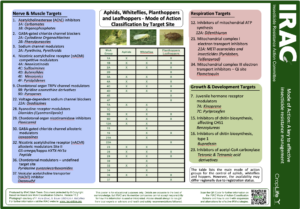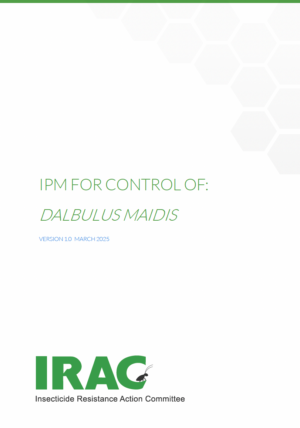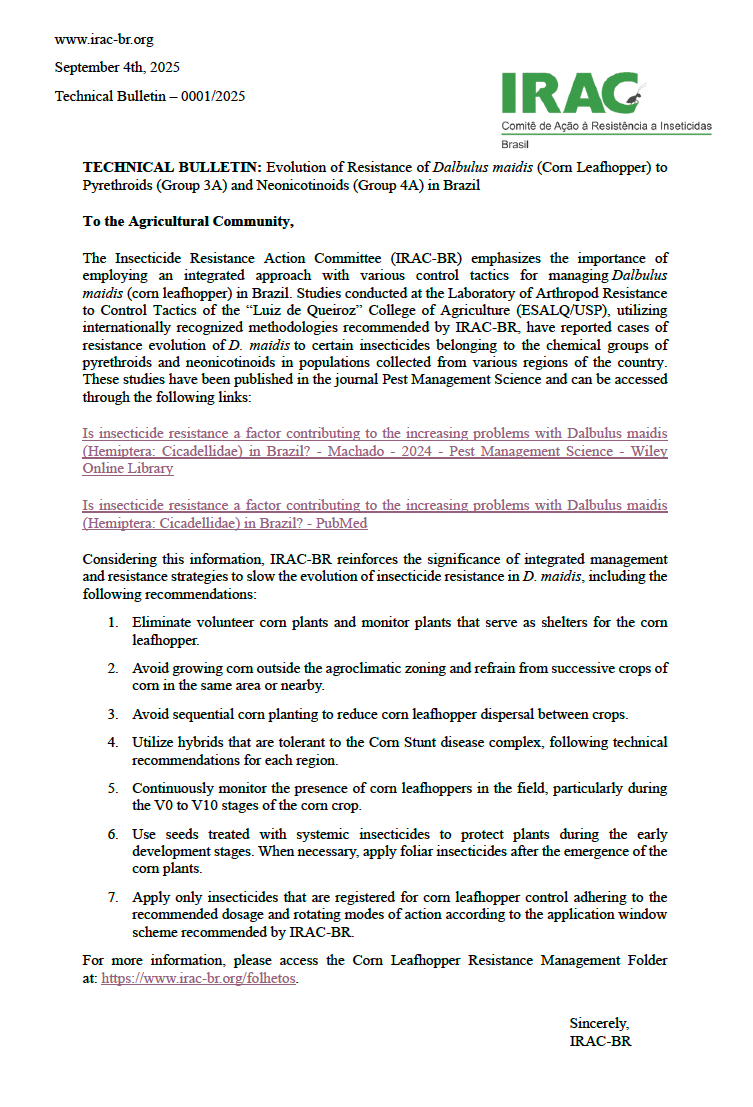Corn leafhopper
Dalbulus maidisThe corn leafhopper, Dalbulus maidis (Hemiptera: Cicadellidae), is an important pest of corn in Brazil. Originally from Mexico, it is found throughout North and Latin America. First detected in Brazil in the 1980s, a significant increase in this pest was observed starting primarily in 2015 and continued in subsequent seasons. Increasing maize cultivation areas, long cultivation seasons (first, second and third crop), widespread availability of volunteer maize plants and secondary hosts (other grasses) and the ability of Dalbulus to migrate indicate that a high infestation pressure is likely to continue. The main importance of the corn leafhopper stems from its role as a vector of important corn diseases, such as Maize Rayado Fino Virus (MRFV), Corn Stunt Spiroplasma (CSS), and Maize Bushy Stunt Phytoplasma (MBSP). Furthermore, Maize Striate Mosaic Virus (MSMV) has been documented more recently. Symptoms become visible 15 to 20 days after infection (especially for viral infections). These symptoms include stunted plants, shortened internodes, chlorotic or red stripes on the leaves, and poor grain formation. However, most of the damage is not visible until after tasseling and becomes most evident at the end of the crop season. Estimates indicate that corn stunt in Brazil can cause economic losses of up to 70%.
The adults of D. maidis are light brown, measuring 3.7 to 4.3 mm long. They have two large dark spots on the head over the ocelli. These adults exhibit a high capacity for dispersal, moving efficiently between plants and across cornfields. Eggs are laid within the leaf mesophyll and on the midrib. After hatching, nymphs prefer to remain hidden on the underside of the leaves (abaxial surface) for protection from sun, wind, and insecticides. Adults are typically found inside the corn whorl. Biological life cycle goes from 25 to 30 days from eggs to adults, depending on temperature conditions. Adults’ longevity can reach over 52 days. D. maidis can thrive on some grass species, such as wheat, rice, and Brachiaria species. However, the life cycle and reproduction, as well as the transmission of pathogens, have only been confirmed in maize. These biological characteristics contribute to the challenges of controlling this pest.
The main approach that has been used to manage corn leafhopper infestations is the use of chemical compounds: carbamates (IRAC 1A), organophosphates (IRAC 1B), phenylpyrazoles (IRAC 2B), pyrethroids (IRAC 3A), and neonicotinoids (IRAC 4A). Biological products containing the fungi Isaria fumosorosea and Beauveria bassiana have also been shown to be effective tools when used in rotation with traditional insecticides. However, the success of controlling the pest and corn stunt is through IPM implementation, being crucial to combine this approach with corn hybrids that are more tolerant to corn stunt disease. In general, best practices include using tolerant corn hybrids, seed treatment, pest monitoring, rotating chemical and biological products in foliar sprays, and eliminating any remaining corn plants before planting new cornfields.
D. maidis has become more important in Brazil over the last 3 years but recently, Argentina, Paraguay and USA registered the increase of this pest and the incidence of corn stunt disease. The main approach that has been used to manage corn leafhopper infestations is the use of chemical compounds: carbamates (IRAC 1A), organophosphates (IRAC 1B), phenylpyrazoles (IRAC 2B), pyrethroids (IRAC 3A), and neonicotinoids (IRAC 4A). Biological products containing the fungi Isaria fumosorosea and Beauveria bassiana have also been shown to be effective tools when used in rotation with traditional insecticides. The number of insecticide applications on cornfields has increased significantly due to the rising infestations of this pest. In this context, resistance monitoring programs are crucial to maintaining the long-term effectiveness of insecticides.
SUSCEPTIBILITY TEST METHOD
- No validated IRAC Method (July, 2024)
- Machado et al (2024) provides a description of a leaf-dip bioassay based on IRAC Method 19 with some adaptation.
Corn leafhopper resistance profile
High levels of resistance (>100-fold) to pyrethroid and neonicotinoid insecticides have been recorded in populations of Dalbulus maidis collected across several Brazilian states, and therefore resistance to these insecticide classes can be considered as widespread in Brazil. A low level of resistance (<20-fold) to carbamate insecticides was also noted in one population collected from Bahia State.
Resistance to other classes of chemistry may also be present in Brazilian populations of Dalbulus maidis, although there´s no published data yet.
Pyrethroid and Neonicotinoid resistant populations of Dalbulus maidis may also exist in other South American countries, but there is no currently published data to verify the presence or absence of resistance.
| Species | Distribution | Chemical class | Mechanisms |
|---|---|---|---|
| Dalbulus maidis | Brazil (Bahia) | Carbamates (1A) | Unknown |
| Dalbulus maidis | Brazil | Pyrethroids-Pyrethrins (3A) | Unknown |
| Dalbulus maidis | Brazil | Neonicotinoids (4A) | Unknown |


